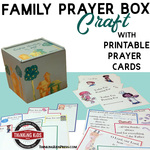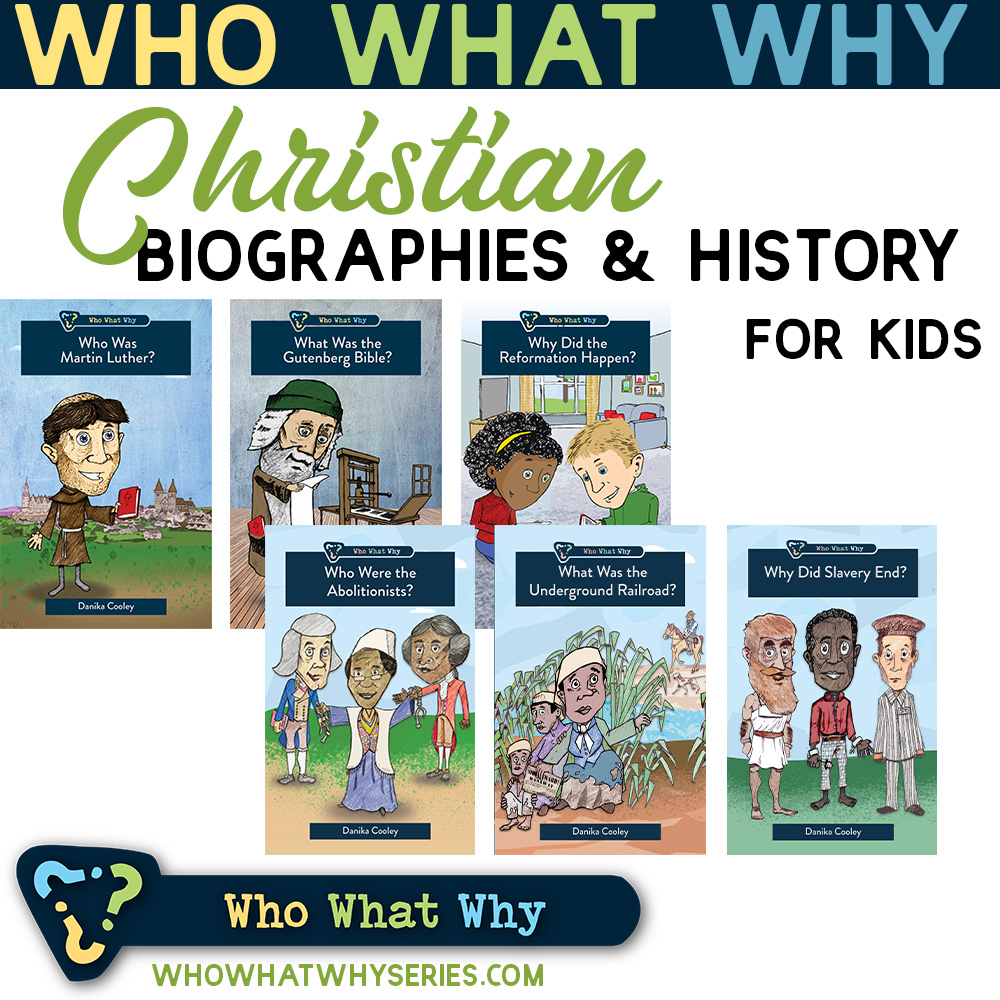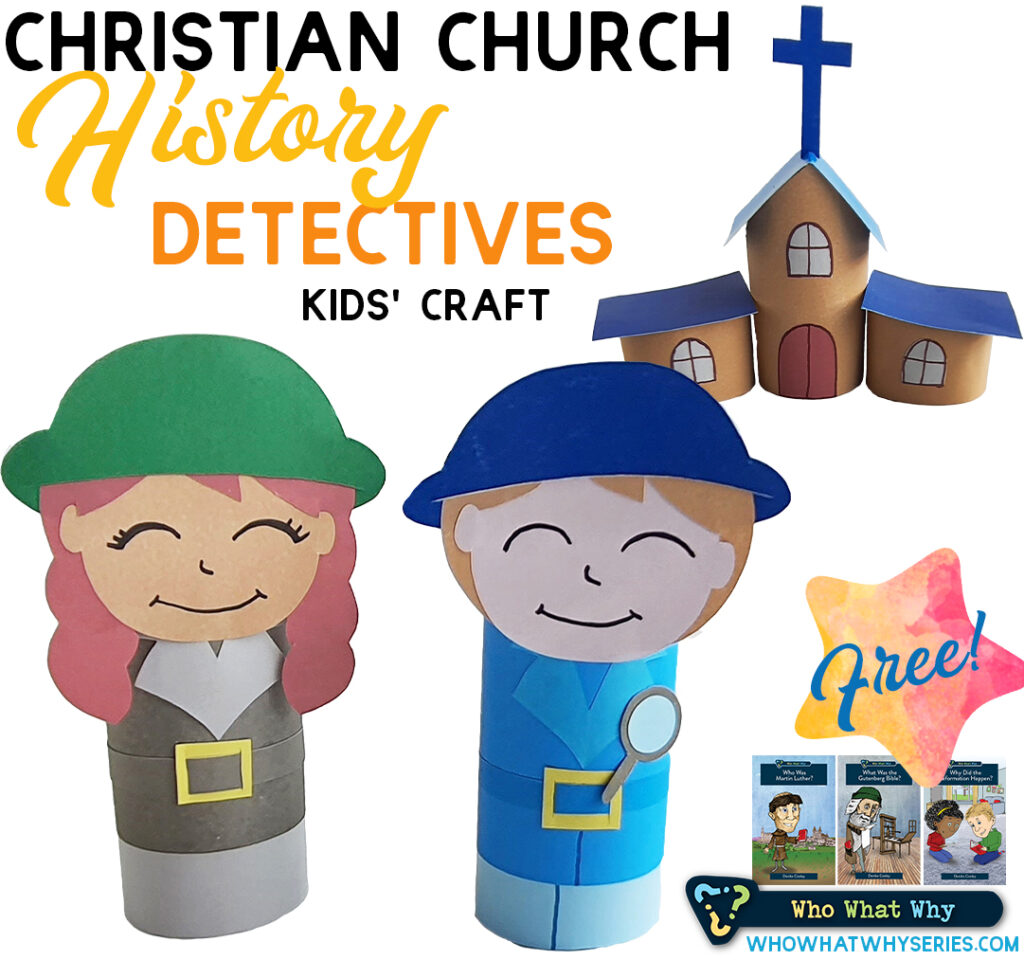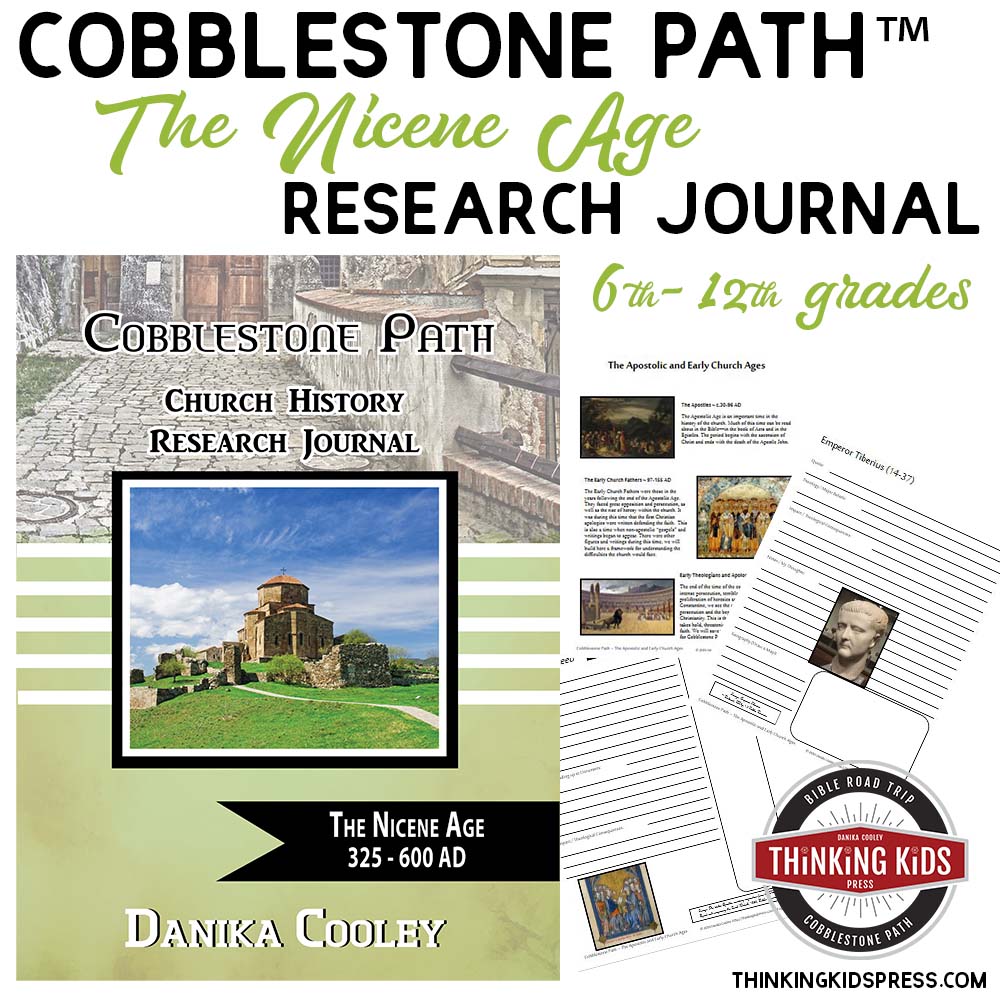
Love them or hate them, these people alter the course of history in such a big way that our children’s history education cannot be complete if they don’t understand who the person is and the choices they made–choices that sent the world on a different path.
Martin Luther of the Reformation was such a person. His fiery wife Katie was a driving force in the middle and end of his life, and the Wittenberg Castle Church was the scene of an event that changed the Christian Church, Europe, and the world.
 Teach your kids about Christian history with the Who What Why series for 8-11 year olds!
Teach your kids about Christian history with the Who What Why series for 8-11 year olds!
Martin Luther of the Reformation
Our kids need to know who the Father of the Reformation was, why he did the things he did, and how his actions changed the course of history!
My narrative biography from Christian Focus Publication, Who Was Martin Luther?, is a fun way for your kids to learn about a man who fought for truth from Scripture: that we are saved in Christ alone by grace alone through faith alone. Martin Luther stood on God’s Word as his authority, rather than the words of councils or men, teaching people to live their lives to the glory of God alone.
God used Martin Luther in history to help reform the Christian Church. His impact helped define a continent, end feudalism, create a new language, and he helped get the Bible translated into the heart languages of people across the world.
If your child worships in a church where they sing praises to God, read the Bible in English, learn from a pastor who preaches from the Bible (and can have a family), and they know the gospel of Jesus Christ, Martin Luther had something to do with that!
Who Was Martin Luther?
Martin Luther was a young man who was afraid of a thunderstorm. He was a monk seeking for salvation. He was a reformer who inspired a continent to return to the Word of God. Introduce your 8–11 year olds to this key figure in the Reformation.
Amazon | Thinking Kids Press | Christian Book
Sometimes the people who change the world come from the most unlikely of places. Places like a little town in a little country no one paid much attention to at the time. Often the people who change the course of history are not all that important seeming until you look back and see what it is they really did with their lives.
Who Was Martin Luther?, Danika Cooley (Christian Focus Publications, 2021), page 9

Toilet Paper Roll Craft for Your Kids
You can help your kids commemorate what they’re learning about history in a hands-on way! Check out this fun video I made of the Martin Luther toilet paper roll craft!
Martin Luther Reformation and 95 Theses Supplies

- Cardstock (colored and white)
- Scissors
- Glue
- Pencil
- Permanent Marker
- Toilet Paper Rolls
- Printable Templates with Instructions
- Don’t forget this fun book that will teach your kids about Martin Luther of the Reformation: Who Was Martin Luther?


Grab the autographed Reformation Family Bundle!
Martin Luther Reformation | Instructions
Your child’s representation of Martin and Katie Luther and the Wittenberg Castle Church are a great way to help them consider what they learn as they read Who Was Martin Luther? from the Who What Why series!
1) Print your templates and labels.

Print the Martin and Katie Luther and castle templates on cardstock, print the label and 95 Theses on cardstock as well. Cut out the labels.
2) Cut out the Martin Luther template pieces.
Print the template page from step-by-step instructions and cut out the pieces for Martin Luther.
Lay the template pieces over the cardstock in the colors your child would like to use for Martin Luther. For historically accurate colors, use black, dark brown, navy blue, and skin-toned cardstock.
Trace the head pattern on the paper selected for the skin tone. Trace the hair pattern on the dark brown paper. Use black paper for the hat pattern, and navy blue for the collar pattern. Cut out the shapes you have traced.
3) Assemble the head of Martin Luther.

Cut a slit along the inner line of the hair pattern as shown. Slide the top side of the head through the slit from below, keeping the top side of the slit to the front side of the head. Glue the head to the hair.

Glue the hat to Martin Luther’s head.

Martin needs a face, so draw one on using your permanent marker. It can be simple and cute like the one in the picture.
4) Assemble the body of Martin Luther.

Cut piece of black paper the size of the whole toilet paper roll. Glue the collar onto the middle of the paper as shown.

Glue the black paper onto the toilet paper roll to create Martin Luther’s body.

Glue Martin Luther’s body to his head.
5) Cut out the Katie Luther template pieces.
Cut out the template pieces for Katie Luther.
Lay the template pieces over the cardstock in the colors your child would like to use for Katie Luther. For historically accurate colors, use white, black, dark brown, red (or peach), and skin-toned cardstock.
Trace the head pattern on the paper selected for the skin tone. Trace the hair pattern on the dark brown paper. Use black paper for the hat pattern, and red for the small square and strip patterns. The large square shape should be used on white cardstock. Cut out the shapes you have traced.
6) Assemble the head of Katie Luther.

Cut a slit along the inner line of the hat pattern as shown and glue the red arch to the bottom side of the top part of the slit. Glue Katie’s hair onto her head. Glue the red square to the middle part of the white rectangle as shown.

Slide the top side of the head through the hat slit from below, keeping the top side of the slit to the front side of the head. Glue the head to the hat.
Give Katie a face as shown with your permanent marker. Use your marker to create a corset pattern on the lower half of her bodice (the white rectangle).
7) Assemble the body of Katie Luther.

Cut piece of black paper the size of the whole toilet paper roll. Glue the bodice piece onto the middle of the paper as shown.

Glue the black paper onto the toilet paper roll to create Katie Luther’s body.

Glue Katie Luther’s body to her head.
8) Apply the Martin Luther and Katie Luther labels.

Glue on Katie and Martin’s label names onto the bottom front of their bodies as shown. Having the labels will be helpful when you do your Gutenberg Printing Press and The Reformers crafts!
9) Print and cut out the Wittenberg Castle Church template pieces.
Print the template page from step-by-step instructions and cut out the pieces.
Lay the castle template pieces over the cardstock in colors your child chooses. Trace the pieces on the cardstock and cut out the pieces.
10) Assemble the main castle.

Glue the castle door onto the wider square on the left hand side. Fold the gatehouse along the vertical lines.

Apply glue along the thin folded part, then glue it to the other side to form the gatehouse.

Glue the border along the top side of the gatehouse. Then, glue on the roof of the gatehouse.
11) Cut out the templates for the castle towers.

Trace the window templates onto cardstock and cut out the windows.
12) Assemble the castle towers.

If your child wants colored castle towers, help them wrap the towers in colored cardstock and glue it on. Glue the windows to the the towers.

Trace the cone template onto cardstock of your twice. You will need to create two cones. Cut out both cones.

Roll and join the open sides of the cones, then glue the edges together. Glue each roof to the top of each tower.
13) Assemble the castle and apply the 95 Theses.

Glue one tower to the back of each side of the gatehouse. Your child can add details with a permanent marker. Glue the Ninety-Five Theses scroll to the castle.
14) Display your Martin Luther of the Reformation toilet paper roll craft.

Martin and Katie Luther and the Wittenberg Castle Church are great reminders of every thing your kids will learn as they read Who Was Martin Luther?, from the Who What Why Series Christian history series!

Learn more about the Who What Why series and get your FREE Abolition Lapbooks here.
Bible Resources for Your Kids
Learn More HereLearn More HereLearn More HereLearn More HereLearn More HereLearn More Here
Christian Biographies for Kids | Christian History for Kids | Theology for Kids

Christian History Matters for Our Kids.
History matters. Now, more than ever, we see how important it is for our children to know and understand history and the Bible.
Here’s why:
- God is the sovereign ruler of all things. It’s important for our kids to see his hand in the history of nations and in the lives of both peasants and kings.
- Christian history is the story of our family history. Our kids get to see how people who love Jesus follow him.
- Understanding history can help our kids learn historic and biblical theology. They learn what the Bible says and what that means for us. They also see when the study of Scripture has taken important turns that have changed the Church.
- Reading Christian biographies and history can be a wonderful way for kids to think outside their own time and culture. God’s Church spans centuries and includes people from every nation.
- Christian biographies help kids consider their own faith, walk with Jesus, and the impact their witness may one day have on others–and on history.




Grab the autographed Reformation Family Bundle!
More Thinking Kids Posts You’ll Love!

Join the newsletter

Get the Family Prayer Box Project FREE!
Teach your children to pray with this fun project that includes 7 printable sets!








































































Leave a Reply